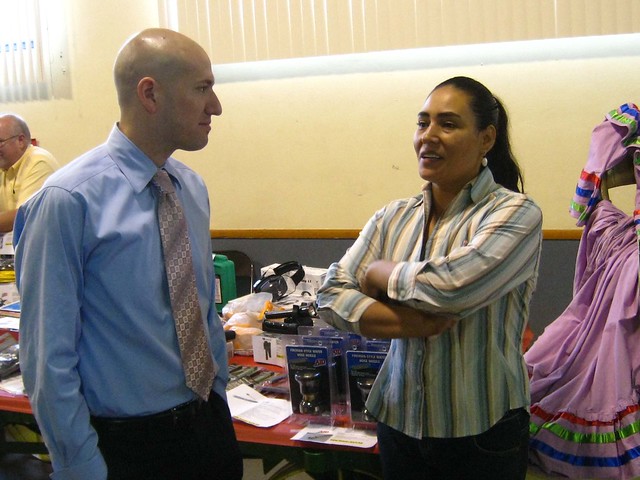I remember an HR professional telling me years ago that they tended to hire for hard technical skills and ended up firing for a lack of soft skills. He wanted to figure out ways to close this gap. This manager was ahead of his time. Back then he saw the need that Dan Schawbel refers to in his recent predictions for 2011 where he asserts that soft skills, including verbal communication, will be more important than hard skills for workplace success.
Going soft
 But when and where are soft skills being taught? Not everyone is fortunate enough to have been raised in a supportive family that demonstrated and taught the necessary skills to interact effectively. In many cases we naturally respond to other people in the same way we prefer others respond to us. Although this may work well when the other person shares our communication style, the “one way fits all” interaction approach can create problems in other cases. When creating your personal brand and interacting in the workplace, you must be able to communicate with anyone, not just with those who share your approach.
But when and where are soft skills being taught? Not everyone is fortunate enough to have been raised in a supportive family that demonstrated and taught the necessary skills to interact effectively. In many cases we naturally respond to other people in the same way we prefer others respond to us. Although this may work well when the other person shares our communication style, the “one way fits all” interaction approach can create problems in other cases. When creating your personal brand and interacting in the workplace, you must be able to communicate with anyone, not just with those who share your approach.
Your personality can help
Personality type preferences, that look at alternative, healthy approaches to dealing with the world, taking in information, and making decisions, can give us a clue to possible miscommunications. Knowing your preferences for Introversion and Extraversion is the first step toward understanding how you come across – essential information for relating to anyone.
In the personality type model, Introversion and Extraversion are alternative ways of becoming energized. Everyone spends time Extraverting (dealing with the outer world) and Introverting (reflecting on matters). Those who prefer Introversion would rather spend time and energy in the inner world, pondering and deeply processing information. Those who prefer Extraversion, in contrast, would rather spend time and energy in the outer world, interacting and acting. Most people can easily identify the mode they prefer.
How we get into trouble
When communicating, people who prefer Extraversion and those preferring Introversion may misunderstand each other. Extraverts communicate frequently with lots of energy and may interrupt and finish each others’ sentences. Although this can create an interesting conversation, Extraverts could take up excess airspace and not allow pauses for others to speak. They may say things they later regret or confuse people by sharing ideas that are not yet well formulated. Introverts tend to communicate more selectively and often come across as calm and soft-spoken. They usually share well-developed ideas and thoughtful information. However, if the opportunity to share an idea does not present itself, others might not know what an Introvert is thinking or even confuse their quiet persona as disinterest.
How to get out of trouble
What is your communication preference? When does it work well and when might it be better to accommodate another approach? Here are a few tips to help Extraverts and Introverts communicate more effectively.
If you have a preference for Extraversion:
- Pause after you finish talking, especially when you are asking a question. This gives time for others to think before speaking.
- Remember that others may not think out loud and they may place great weight on what is said. Take more time to think before speaking to reflect on how others might respond.
- Think twice before interrupting someone who is working. Even though a discussion might be valuable for you, others may find the interruption an unwelcome distraction.
- Ask people to give their opinions, and then listen carefully.
- Assess your body language. You may be saying more than you know. Perhaps you need to tone down your expressions or your gestures.
If you have a preference for Introversion:
- Use cue words such as “let me think about that” or a simple “hmm…” to fill in a pause and let others know you are planning to respond.
- Remember that some people think out loud. They may have less investment in their words than you might believe. Don’t assume that everything said is well thought out.
- At times, speak up earlier and more often than you may prefer. To make this easier, plan what you might say in certain circumstances.
- Make the effort to initiate conversations and interactions.
- Assess your body language. Even if you are listening carefully you might not be showing your interest. Practice non-verbal cues such as using more facial expressions or nodding in agreement when others are talking.
Your personality brand
As well as accommodating others, use your preference for Extraversion or Introversion to help define your personal brand. Perhaps being expressive, outgoing, action-oriented, and lively are words that describe your approach. Or maybe reflective, calm, careful, and contemplative are more characteristic of your style. Make your personality part of the brand.
Use your natural approach when appropriate and accommodate others when necessary for more effective and inclusive interactions. When Dan’s prediction comes true, you’ll be ready to promote yourself by relating to anyone.
Author:
Donna Dunning, PhD, is a psychologist, certified teacher, member of the MBTI ® International Training Faculty, and director of Dunning Consulting Inc. She is the author of more than a dozen publications, including her two newest books, 10 Career Essentials and What’s Your Type of Career? 2nd edition. Donna’s guiding principle is: Know yourself, respect differences, learn and grow. Follow Donna on Twitter and Facebook and visit her website.






